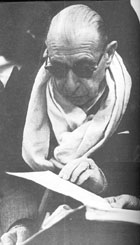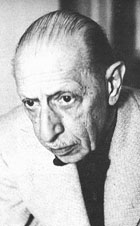The Rite of Spring: Sacrificing Continuity by Pierre Grondines
/ March 1, 2000
Version française...
 Igor Stravinsky (1882-1971) once mentioned how, just as he was putting the last
touches to the score of The Firebird, he was overcome by a vision.
"In my imagination, I saw a great pagan rite. The elders were seated in a
circle watching the death dance of a young girl who was being sacrificed to
propitiate the god of spring." The vision and the music came to Stravinsky
at the same moment, and his hands immediately moved over the piano, playing a
jittering motif. It took a long time for the composer to actually pin down the
musical notation, however, because of its rhythmical complexity. Thus was born
the "Danse sacrale," the final scene of The Rite of Spring. The
ballet, described as "scenes from pagan Russia in two parts," was to
be one of the most daring ever mounted by Diaghilev's Ballets Russes.
Igor Stravinsky (1882-1971) once mentioned how, just as he was putting the last
touches to the score of The Firebird, he was overcome by a vision.
"In my imagination, I saw a great pagan rite. The elders were seated in a
circle watching the death dance of a young girl who was being sacrificed to
propitiate the god of spring." The vision and the music came to Stravinsky
at the same moment, and his hands immediately moved over the piano, playing a
jittering motif. It took a long time for the composer to actually pin down the
musical notation, however, because of its rhythmical complexity. Thus was born
the "Danse sacrale," the final scene of The Rite of Spring. The
ballet, described as "scenes from pagan Russia in two parts," was to
be one of the most daring ever mounted by Diaghilev's Ballets Russes.
As everyone knows, the première of The Rite of Spring on May 29, 1913 at
the Champs-Élysées Theatre in Paris caused a near riot among the audience.
From the moment the bassoon sounded the first sharp notes of the score, members
of the audience began to boo and hiss. In no time Stravinsky's supporters were
brawling with the hecklers. The uproar drowned out the music--itself very loud
at times. No one has figured out whether it was Nijinsky's tribal choreography
or Stravinsky's music that caused the most outrage.
The Rite of Spring, both on the stage and in the concert hall, has
continued to cause shockwaves among audiences, and the score has challenged the
imagination of numerous twentieth-century composers. Choreography and riotous
opening nights aside, the extent of its influence is such that we need to ask
what, exactly, gave this music such power. It is no exaggeration to say that The
Rite of Spring is one of the pillars of modern music, along with Prélude
à l'après-midi d'un faune by Debussy (1862-1918), and Pierrot Lunaire
(1912) by Schoenberg (1874-1951).
Sudden breaks
People hearing The Rite of Spring for the first time notice that
several sections break off suddenly instead of coming to a traditional close: a
musical convention that allows us to sense the conclusion of a segment or work.
Instead, Stravinsky slashes the fabric of the music at an unexpected moment,
suddenly replacing one broken off section with a completely different one. This
technique is a radical departure from typical classical or romantic
compositions, where explicit transitions between contrasting sections are the
norm.
Stravinsky's idea of composition
We now realize that composing basically meant opposing for Stravinsky
when he wrote The Rite of Spring. He put in place contrasting elements,
either short or more developed, and then began to make them work in tension to
one another. The opening of "Earth Dance," the final section of Part
1, is a good example. Here, Stravinsky introduces two brief orchestral blocs,
then begins alternating them in a very irregular manner. In the opening of
"Games of Rival Cities" he uses a similar and equally expressive
technique, this time with more extensive orchestral blocs. As Pierre Boulez
noted, Rite of Spring was created with a broad brush.
A precedent
The young Stravinsky, a product of early twentieth-century St. Petersburg,
was influenced by Rimski-Korsakov (1844-1908) in the tradition of Russian
nationalist composers. The source of Stravinsky's taste for discontinuity can be
found in the work of Mussorgsky (1839-1881), in whom he took great interest. For
the composer of Boris Godunov (1869) and Pictures at an Exhibition (1874),
producing works that featured contrasting musical moments provided relief from
the German music of the time, in which continuity was paramount.
Nineteenth-century Russian composers sought to distance themselves from that
sort of music.
Musical time
The strength of The Rite of Spring lay in its brilliant new
conception of musical time, which can be compared to a Cubist painting,
providing a mosaic of different facets of a subject. In The Rite of Spring,
musical discontinuity creates the illusion of time split into fragments that
differ in nature from one another. This new idea of musical time, which
culminated for Stravinsky in Symphonies for Wind Instruments (1920),
appeared in the same quarter century that produced Russian film makers such as
Eisenstein (1898-1948), who experimented boldly with the effects of
montage--surely no coincidence.
Avatars
A number of composers between the wars tried to imitate the techniques used
in The Rite of Spring, but few were able to achieve Stravinsky's rhythmic
finesse. For the most part, such works consisted of rhythmic colouring that had
little effect on musical language. These include Carmina Burana (1937) by
Carl Orff (1895-1982), and the music of Prokofiev (1891 1953) and Aaron Copland
(1900-1990). Prior to World War II, only Edgar Varèse (1883-1965), Olivier
Messiaen (1908-1992), and Conlon Nancarrow (b.1912) had grasped the innovations
of the Rites of Spring. Varèse's Amériques (1921), written for a
very large orchestra, is distinctive for its rhythm, which breaks with the
linear tradition of the romantic period, and for its repetitive melodies as well
as its earthy quality. Amériques shows the surprising mastery with which
Varèse very quickly assimilated the best of Stravinsky's work when it was still
new to the public.
Disciples
 Beginning in the 1930s, Messiaen included in his work rhythmic innovations
garnered from The Rite of Spring. In 1939 he published Le rythme chez
Stravinsky, an article describing the guiding principles of Stravinsky's
music. Messiaen, who began teaching at the Paris Conservatoire in 1942, quickly
attracted the best young composers from around the world. Among his disciples
were Pierre Boulez, Iannis Xenakis, Karlheinz Stockhausen, György Kurtág,
Serge Garant, Gilles Tremblay, and many others. The Rite of Spring was
taught as a firmly established twentieth-century classic. Pierre Boulez also
made a significant contribution to publicizing the rhythmic techniques of this
work in a remarkable analysis published in 1951.
Beginning in the 1930s, Messiaen included in his work rhythmic innovations
garnered from The Rite of Spring. In 1939 he published Le rythme chez
Stravinsky, an article describing the guiding principles of Stravinsky's
music. Messiaen, who began teaching at the Paris Conservatoire in 1942, quickly
attracted the best young composers from around the world. Among his disciples
were Pierre Boulez, Iannis Xenakis, Karlheinz Stockhausen, György Kurtág,
Serge Garant, Gilles Tremblay, and many others. The Rite of Spring was
taught as a firmly established twentieth-century classic. Pierre Boulez also
made a significant contribution to publicizing the rhythmic techniques of this
work in a remarkable analysis published in 1951.
The Rite of Spring left its tumultuous 1913 début far behind to become a
cornerstone of composition. From the fragmentation of musical time to a kind of
immobility in movement, the seminal ideas that emerged in this work have been
taken up and transformed by various composers during the last fifty years. Works
like Messiaen's Turangalila-symphonie (1948), Gruppen (1957) by
Stockhausen (b.1928), Pléiades (1978) by Iannis Xenakis (b.1922), Earth
Dances (1986) by Harisson Birtwistle (b.1934), or De Staat (1995) by
Louis Andriessen (b.1939) demonstrate that Stravinsky's sacrificing of musical
continuity brought the twentieth century an abundant flowering of radical new
music.
Version française... |
|


